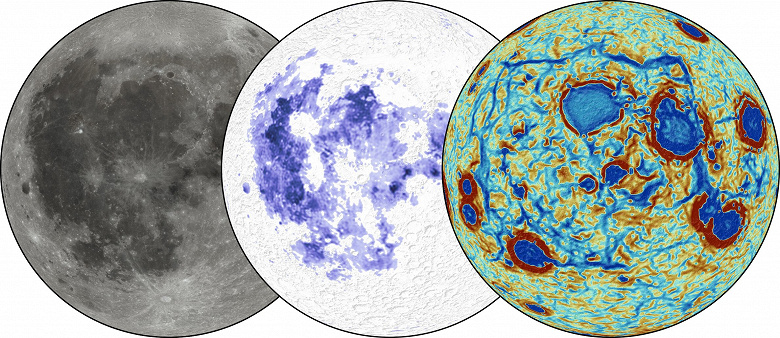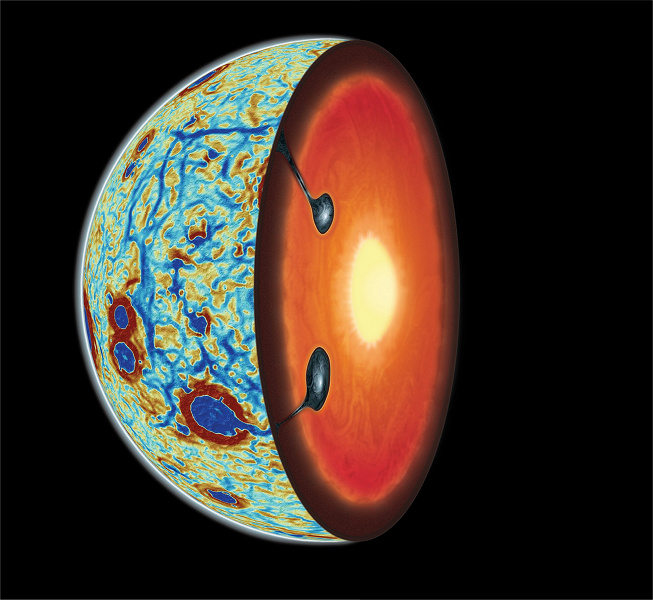Measurements of gravitational anomalies help reveal what is hidden deep under the surface of the Moon
About 4.5 billion years ago, a small planet collided with the young Earth and ejected molten rock into space. These debris slowly cooled and solidified, forming our Moon. Although most scientists adhere to this scenario, the details of the process are still the subject of debate and mystery.
Researchers from the University of Arizona's Lunar and Planetary Laboratory have published a paper in the journal Nature Geoscience in which they detail new research findings that could help understand not only the origin of the Moon, but also the evolution of planets such as Earth and Mars .
At the moment, most of our knowledge about the origin of the Moon is based on the analysis of soil samples brought by the Apollo astronauts and on theoretical models. Astronauts brought back samples of basaltic lava rocks from the Moon that have unusually high concentrations of titanium. Later satellite observations showed that these rocks are mainly located on the near side of the Moon. However, the process that led to this distribution and the reason why these rocks ended up in this particular area remain a mystery.
Because the Moon formed quickly, it was likely covered by an ocean of magma and gradually cooled, resulting in the formation of a mantle and crust. However, below the surface, the young Moon was not in balance. Models suggest that the remnants of the magma ocean eventually crystallized into minerals including ilmenite — mineral rich in titanium and iron.
«Because these minerals are denser than the mantle below, they created a gravitational instability, causing this layer to sink deeper into the bowels of the Moon», — said Weigang Liang, director of the study.
At what point and how this dense material returned to the surface in the titanium-rich lava flows we see today remains a question.
«The moon literally turned inside out. But there was little evidence that could shed light on the exact sequence of events at this stage of lunar history, and much disagreement about the details of what happened, — says co-author Jeff Andrews-Hanna.
Scientists debate whether this material sank gradually as the Moon cooled, or whether it all sank inward and then rose again on the near side. There is also a version that this material could have sunk as one large formation or several individual fragments.
«Without evidence, you can choose your favorite model. Each model has important implications for the geological evolution of the Moon», — said co-author Adrien Broquet of the German Aerospace Center in Berlin.

In a previous study by Nan Zhang of Peking University, who is also a co-author of this paper, models showed that a dense layer of titanium-rich material first migrated to the near side of the Moon and then sank into the inner part of the Moon as networks of lamellar plates descending into the bowels of the Moon. But when this material sank, it left behind titanium-rich material under the crust.
«When we saw these model predictions, it was like a light bulb went on»,— Andrews-Hanna said, — «because we see exactly the same ??same picture when we look at changes in the gravitational field of the Moon, discovering a network of dense material hiding under its crust».
In a new study, scientists compared simulations of a subducting layer containing ilmenite with data on gravity anomalies collected by NASA's GRAIL mission (Grail from the Global Positioning System (GPS) or Gravity Recovery and Interior Laboratory. The mission's two spacecraft rotated around the Moon between 2011 and 2012 and measured minute changes in its gravitational pull.Gravity anomalies surround a large dark region on the near side of the Moon that is covered in volcanic flows.
The authors found that gravity measurements from the GRAIL mission were consistent with simulations of the ilmenite layer. This allows us to map the distribution of ilmenite remains after most of the dense layer has subsided.
«Our analysis shows that the models and data tell one consistent story», — said Weigang Liang, — «Ilmenite material migrated to the near side of the Moon and sank inward in plate-like cascades, leaving traces that cause anomalies in the Moon's gravitational field, as seen in data from the GRAIL mission».
The study also helped limit the timing of this event. Gravity anomalies terminate at large and old impact basins on the near side of the Moon, and therefore they must have formed earlier. Based on these connections, scientists suggest that the ilmenite-rich layer sank more than 4.22 billion years ago, which corresponds to the time when later volcanism occurred on the Moon's surface.
However, scientists note that although the discovery of anomalies in the Moon's gravity provides evidence of the immersion of a dense layer in its interior, the surface of the Moon still remains an open question in the history of its evolution.
As Andrews-Hanna points out, the Moon is one-sided in many ways. The Moon's near side, facing Earth, and the particularly dark region, Oceanus Procellarum, are lower in altitude, have thinner crust, and are mostly covered in lava. They also contain high concentrations of commonly rare elements such as titanium and thorium.
The far side of the Moon is different from the near side in every aspect. The flip of the lunar mantle is thought to be related to the unique structure and history of the nearby Procellarum region. However, the details of this coup are controversial among scientists.
This work links geophysical data about the Moon's internal structure with computer models of its evolution. And this is the first evidence of what happened inside the Moon at the stage of its evolution.
Andrews-Hanna says: «It turns out that the Moon's earliest history is recorded beneath the surface, and it only took the right combination of models and data to uncover that history».
Further missions, such as the use of a seismic network, will allow us to study the geometry of these structures in more detail and further understand the evolution of the Moon.

